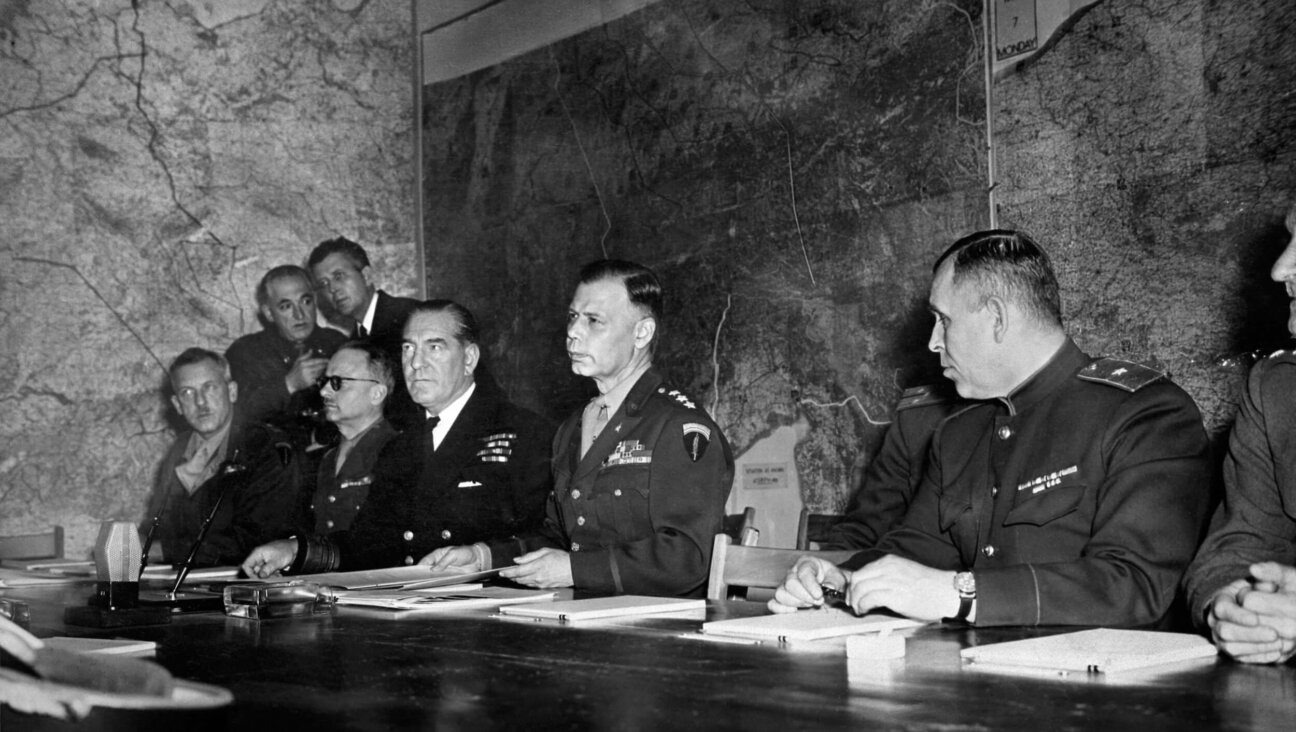(Orthodo)X-Men, On Screen and Off
In our May 23 issue, Ami Eden argued that the opposing forces in the blockbuster film, “X2: X-Men United,” could be interpreted as metaphor for two radical theological responses to the Holocaust — one belonging to Rabbi Irving “Yitz” Greenberg, the other to the late Rabbi Meir Kahane. The good-guy mutants, Eden noted, are led by the wheelchair-bound Professor X (played by Patrick Stewart), a powerful psychic with an ideological — and physical — resemblance to Greenberg. Professor X remains dedicated to coexistence between mutants and non-mutants, while his nemesis and lifelong friend Erik Magnus Lehnsherr, aka Magneto (Ian McKellen), is convinced that a war between the two groups is inevitable. Apparently, the analogy was closer than we thought.
Ami Eden’s article was creative, insightful, clever and funny. I enjoyed and agreed with it even before he made me as handsome as Patrick Stewart. Readers might be interested to learn that the article cut much closer to the bone than even Eden may have realized.
Like Professor X and Magneto, Meir Kahane and I started out as good friends. During our high school years we were classmates and joint performers in weekly skits that we often wrote together. We both sensed that Jewish history was undergoing one of its great transformations (although, I confess, I do not remember if we both had zeroed in on the significance of the Holocaust as fully as we were to do later). We debated frequently, often over the use of force by the Jewish underground in Palestine during the 1940s.
Even then, Kahane’s most striking characteristics were strongly apparent. As early as his teen years, he displayed a preference for extreme and “pure” solutions. He always had a strong ability to reach audiences and touch people, but he was overly influenced by their reactions, becoming more extreme in order to elicit an even more enthusiastic response.
Kahane always displayed a quick mind and nimble tongue, but lacked what in Yiddish we call sitzfleisch, namely, patient attention to detail to back up his words. In school, he cut corners on his homework; later on, he had no penchant for the detailed, laborious organizing necessary for success in organizational life. This explains why although he received a great deal of worldwide media attention — which he could have utilized to create the most powerful mass movement or organization in Jewish life — he piddled his public-relations gains away. When Kahane was killed in 1990, he left behind the Jewish Defense League and the Israeli Kach Party, two organizations that had been the recipients of major news coverage, but lacked a stable residue of power or effectiveness.
Decades before his death, in college, our contacts first began to wane. I left to pursue a PhD in American history at Harvard, and he to pursue a somewhat-mysterious exploration of the CIA and the fringes of American politics. But catalyzed by our powerful encounters with the Holocaust, we both moved back to callings that were more Jewish and we each developed what would become opposing philosophies in reaction to the tragedy.
(Eden wrote, “Greenberg argued that the Holocaust represented an abrogation of the divine covenant with the Jewish people.” I actually argued that the authority of the covenant was broken but the Jewish people, released from its obligations, chose voluntarily to take it on again.)
Our paths converged again during the Soviet Jewry movement in the late 1960s. We were both highly critical of the Jewish establishment for its complacency regarding the plight of Soviet Jews denied the right to emigrate. However, I was involved with Jacob Birnbaum and the Student Struggle for Soviet Jewry. The young activists who did the hard work of organizing demonstrations and educating the public were angered that Kahane often snatched up the media attention by resorting to violence in ways which many felt undercut the moral standing of the movement. Kahane would come to rallies and grab the spotlight or the microphone, attracting media attention with calls for more extreme policies. But I believed that multiple tactics had a certain value, and Kahane and I renewed our old debates when he came to speak at a men’s club breakfast at Riverdale Jewish Center, where I served as rabbi.
The alienation between us began to grow, however, as his policies became more extreme. In 1972, when I was teaching at City College of New York, one of my students was arrested by the FBI for placing a bomb in mega-entertainment agent Sol Hurok’s office, to punish Hurok for sponsoring a Soviet artist’s concert tour in America. The bomb killed a secretary. In my conversations with the student he made clear that he believed he had acted under the inspiration of Meir Kahane and even hinted that my old friend had encouraged the bombing, though the FBI never proved anything. When, during an encounter with Kahane, I accused him of possible responsibility for the secretary’s death, he argued that “never again” meant “never again at all costs” — including the use of force and violence.
We met again years later, for yet another debate. Kahane had made inroads, particularly in the Yeshiva University student community, by cloaking his proposals for elimination of the Arabs with rabbinic sources. Rabbi Avi Weiss, who was a friend of both of ours, came to me and asked if I would debate Kahane. I felt that his ideology and incorrect use of rabbinic sources needed to be challenged — he was a bad influence on Y.U. students. So I agreed to debate him at the Hebrew Institute of Riverdale, the synagogue headed by Weiss.
The week before the debate, an interview with Kahane appeared in the Baltimore Jewish Times. The report was horrific. He called for the transfer of the Arab population of the West Bank. As I recall it, he spoke of bringing trucks and rounding up the population — men, women and children — and depositing them in Jordan. When asked by the reporter what would happen if they refused to go, Kahane replied: We will shoot them if they resist.
On the night of the debate, I opened by reading back to him his horrible words, adding that I hoped they were journalistic misrepresentations. He responded almost mockingly that he stood behind the words, and that only bleeding heart liberals would object. As he spoke, his young, emotionally childish supporters cheered and applauded wildly, arousing him to further excess.
Shocked and appalled, I reminded him that these words read like a script out of the Holocaust. He topped off with an invocation of his version of Jewish power in the light of the Holocaust to frenzied cheers from his claque. As I said at the time, I wanted to tear my clothes, like a mourner, upon hearing such an immoral, evil policy offered by a Jewish leader in the name of the Holocaust.
After the debate, I pledged never to appear with him again. The friendship was broken.
When I heard the news of Kahane’s assassination in 1990, I felt a deep pang — sorrow for his family, regret for the moral distortion and waste of his talents, and pain that a Muslim extremist had successfully committed the murder. I was upset and chagrined that the assassin, El-Sayyid Nosair, escaped the punishment he deserved and was troubled by the FBI’s poor handling of the case. Later I was stunned to learn of Nosair’s connection to Sheik Omar Abdel-Rahman and the realization that the FBI had botched uncovering this terrorist cell years before it struck at the World Trade Center in 1993.
As I brooded over Kahane’s death years later, it dawned upon me that the Jewish Defense League founder had repeated the disabling error that he had committed often in his career. Confusing words with reality, as if brilliant or biting slogans turn into facts by themselves, he spoke hard, provocative and powerful words against Arabs — but organized no force or power behind his pronouncements.
At the same time that he was provoking anger and drawing the attention of Muslim extremists, he confused his own macho words with reality; he never developed the kind of security network that he needed for his protection. Certainly, his failures were not a capital crime and his assassination was a totally unjustified terrorist action. But the ending made his life and his death all the more heartbreaking.
Kahane tapped into the great truth of needing to learn from the Holocaust the lessons of Jewish particularism, self-interest and Jewish power. By pushing his insights far beyond their proper limits and by dismissing the dialectical truths of universalism, moral responsibility to the other and self-restraint, Kahane twisted the Holocaust into a force for abusing others. He underestimated the capacity of the Jewish people to endure frustration and suffering without losing its moral compass and its ability to persist with firm hope until it wins a true peace. This ethical steadfastness is apparent after 55 years of Israel living with intransigent Arab hostility.
Rabbi Irving Greenberg is president of the Jewish Life Network/Steinhardt Foundation.
The Forward is free to read, but it isn’t free to produce

I hope you appreciated this article. Before you go, I’d like to ask you to please support the Forward.
Now more than ever, American Jews need independent news they can trust, with reporting driven by truth, not ideology. We serve you, not any ideological agenda.
At a time when other newsrooms are closing or cutting back, the Forward has removed its paywall and invested additional resources to report on the ground from Israel and around the U.S. on the impact of the war, rising antisemitism and polarized discourse.
This is a great time to support independent Jewish journalism you rely on. Make a gift today!
— Rachel Fishman Feddersen, Publisher and CEO
Support our mission to tell the Jewish story fully and fairly.
Most Popular
- 1

Culture Cardinals are Catholic, not Jewish — so why do they all wear yarmulkes?
- 2

News School Israel trip turns ‘terrifying’ for LA students attacked by Israeli teens
- 3

Fast Forward Ye debuts ‘Heil Hitler’ music video that includes a sample of a Hitler speech
- 4

Fast Forward Student suspended for ‘F— the Jews’ video defends himself on antisemitic podcast
In Case You Missed It
-

Yiddish קאָנצערט לכּבֿוד דעם ייִדישן שרײַבער און רעדאַקטאָר באָריס סאַנדלערConcert honoring Yiddish writer and editor Boris Sandler
דער בעל־שׂימחה האָט יאָרן לאַנג געדינט ווי דער רעדאַקטאָר פֿונעם ייִדישן פֿאָרווערטס.
-

Fast Forward Trump’s new pick for surgeon general blames the Nazis for pesticides on our food
-

Fast Forward Jewish feud over Trump escalates with open letter in The New York Times
-

Fast Forward First American pope, Leo XIV, studied under a leader in Jewish-Catholic relations
-
Shop the Forward Store
100% of profits support our journalism
Republish This Story
Please read before republishing
We’re happy to make this story available to republish for free, unless it originated with JTA, Haaretz or another publication (as indicated on the article) and as long as you follow our guidelines.
You must comply with the following:
- Credit the Forward
- Retain our pixel
- Preserve our canonical link in Google search
- Add a noindex tag in Google search
See our full guidelines for more information, and this guide for detail about canonical URLs.
To republish, copy the HTML by clicking on the yellow button to the right; it includes our tracking pixel, all paragraph styles and hyperlinks, the author byline and credit to the Forward. It does not include images; to avoid copyright violations, you must add them manually, following our guidelines. Please email us at [email protected], subject line “republish,” with any questions or to let us know what stories you’re picking up.















